- Home
- Products
- JUVIAGEL – Vaginal moisturizing gel
- MOMAID – After delivery supplement for postpartum recovery
- PROTECTA – Anti-inflammatory skin cream
- INCOXIL – Incontinence dietary supplement
- VITAPHASE– Special dietary supplement adjusted to the phases of the menstrual cycle
- CORTEXIUM – Addressing cognitive challenges in pre-and post-menopausal women
- Pipeline
- Company

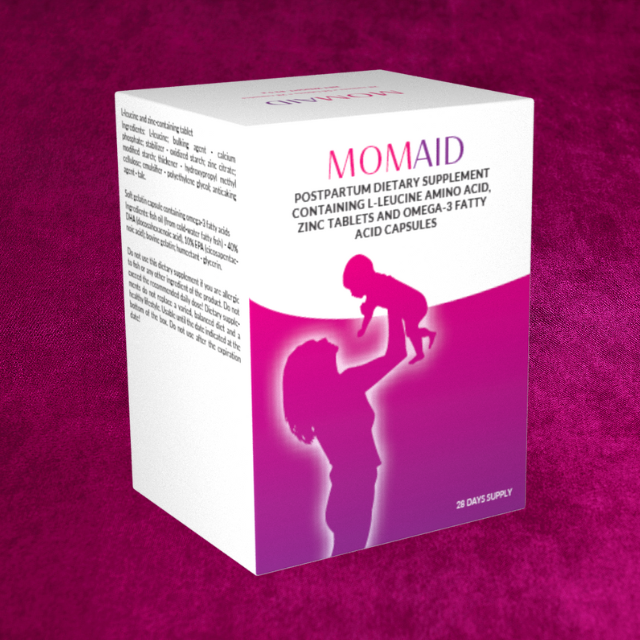
MOMAID After delivery supplement for postpartum recovery
At a glance
MOMAID is a proprietary dietary supplement aimed to improve the recovery of the over-exerted, loose, or even injured muscles of the pelvic floor and perineum. MOMAID contains a patented combination of minerals, unsaturated fatty acids (omega-3 fatty acids) and essential amino acids, which may assist in the restoration of the body after giving birth.
Medical need
During the lifetime of a woman the vagina, the abdominal wall and pelvic organs undergo significant changes. One of the most spectacular biological adaptations is the transformation of the pelvic floor, the pelvic floor muscles, and the vagina to prepare for the labor/delivery and regenerate to normal condition after delivery. Delivery takes a huge toll on women’s pelvic floor. For example, the vagina expands significantly during delivery, and the pelvic muscle (musculus levator ani) goes through similar expansion. The course of the expansion often (15-30%) results in severe muscular injuries that may affect the entire pelvic floor. This is true for natural birth as well as during cesarean section after labor. After normal delivery, a quarter of women suffer from a degree of incontinence, prolapse or vaginal laxity due to the weakening of the pelvic muscles. The weakened, damaged muscle can have a negative effect on sexual intercourse as well. These changes affect women’s general well-being. After further pregnancy and delivery, symptoms tend to get worse, and this can be traced back to the inadequate regeneration of pelvic floor muscles. At a younger age the body quickly regenerates the affected muscles, but later in menopause, prolapse and urinary incontinence may recur as a result of the general weakness of the connective tissue and muscles due to aging.
After delivery, it is essential that the pelvic floor muscles get back to their original condition, so regeneration after delivery should be of critically important. If any assistance can be provided for regeneration, it must be started right after delivery.
The most critical phase of maternal recovery is the first 12 months after delivery. This period is unique: its specific hormonal and immune state does not happen again at any other time.
Market situation
Many companies offer postnatal dietary supplements around the world all targeting only lactation. Currently no existing supplements in the market targeting the recovery of muscles injured during delivery. There is a clear gap on every market which MOMAID can fill. There are around 140-150 million child births worldwide. As surveys show 97% of women in developed countries take prenatal vitamins and 75% of women take postnatal vitamins after the baby is born.
Efficacy of Mommytoo
In order to examine the therapeutic effects of Mommytoo, a seven-month long clinical study was conducted in 2018 at the Department of Obstetrics and Gynecology at the University of Debrecen in Hungary. The mothers who took part in the study received vitamin preparations immediately after giving birth. The therapeutic group was taking MOMAID for 6 weeks, while the control group received a standard postnatal vitamin.
Gynecologists examined the regeneration of pelvic muscles 6 weeks after delivery, measuring the strength of pelvic floor muscles, muscle injury, blood zinc levels, and vaginal wall injury.
The chance of weak pelvic floor muscle strength decreased by 52% in the MOMAID group compared to the control group 6 weeks after delivery.
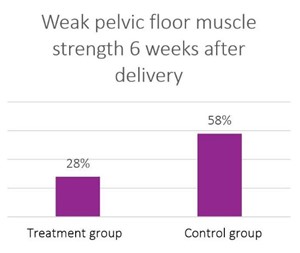
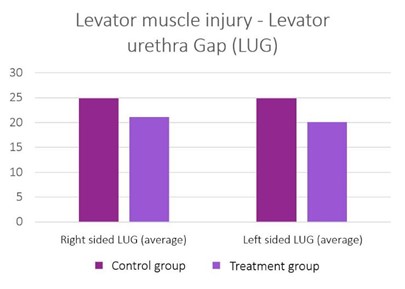
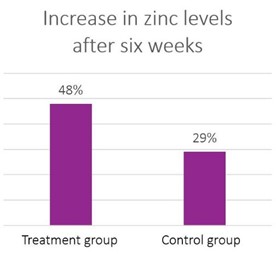
Published on April 03, 2020 at Obstetrics & Gynecology Science 2020;63(3):305-314. Read >>
Safety of MOMAID
Used by thousands of women since 2018 with no complaints. There are no side effects reported at recommended doses. No serious adverse events have been reported with usage.
MOMAID is manufactured in a GMP complying factory and the whole product lifecycle is managed under ISO 22000.
Science behind MOMAID
During pregnancy and childbirth, the female body, especially the pelvic floor is under tremendous amount of stress.
Muscle injuries affecting the pelvic muscles may occur during pregnancy or labour. It is a possibility to sustain pelvic floor injury not just during a natural birth but even after cesarean section. Pregnancy and childbirth cause a degree of pelvic floor dysfunction in one of every three births. The result may be the sagging of the pelvic organs through the vagina (prolapse), urinary or fecal incontinence, or some form of sexual dysfunction.
Maternal age and the number of births increases the likelihood of problems as demonstrated by the following graphs, the recovery of pelvic muscles after delivery are therefore critically important.
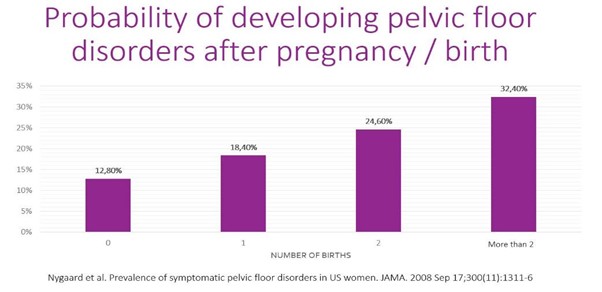
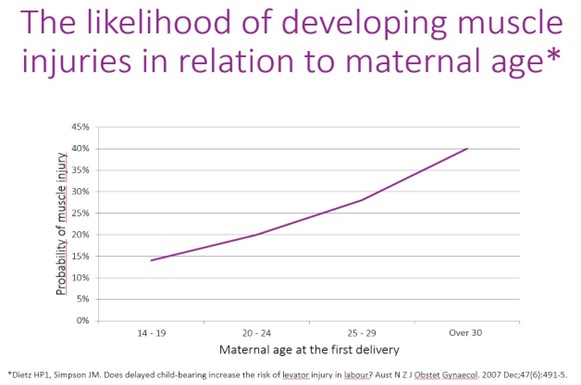
It is necessary for the pelvic muscles to recover as quickly as possible to lessen or eliminate the discomfort caused by muscle damage. Regeneration continues for 12 months after delivery. For effective healing, it is advisable to start the regeneration process immediately after delivery. Unfortunately, the usual prenatal or postnatal vitamins do not provide all the required ingredients.
Clinical effects of the ingredients of MOMAID:
Zinc
In human vaginal smooth muscle cells, zinc has a beneficial effect on the production of extracellular components produced by the muscle at 20 μM zinc tissue level, thereby increasing the amount of collagen and elastin production and the amount of smooth muscle.1
In humans, tissue zinc levels are significantly lower in patients with all types of hernia. The risk factors associated with hernia are similar to those involved in the development of prolapses.2
Even if there is no absolute zinc deficiency in pregnant women, the risk of peripartum and postpartum complications is still increased at a zinc level at the lower end of the normal zinc serum level range. (3, 4, 5)
In a report, the effect of delivery mode (cesarean section or vaginal delivery) was studied on maternal and newborn Mg and Zn blood serum levels. While maternal Mg and Zn levels did not differ before delivery, the plasma Zn level significantly decreased in women who underwent vaginal delivery, relative to the zinc levels of women with caesarean section. This is probably due to the high stress of skeletal muscles and uterine muscles during childbirth. In another study, plasma zinc levels lower than average were associated with complications during pregnancy and during labor and delivery. (6, 7)
Publications
1 Takacs P, Zhang Y, Candiotti K, Jaramillo S, Medina CA. Effects of PPAR-delta agonist and zinc on vaginal smooth muscle cells collagen and tropoelastin production. Int Urogynecol J. 2012;23(12):1775-1779.
2 Ozdemir S, Ozis ES, Gulpinar K, et al. The value of copper and zinc levels in hernia formation. Eur J Clin Invest 2011;41(3):285Y290
3 Schulpis KH, Karakonstantakis T, Vlachos GD, et al. Maternal-neonatal magnesium and zinc serum concentrations after vaginal delivery. Scand J Clin Lab Invest. 2010;70(7):465-469.
4 Lazebnik N, Kuhnert BR, Kuhnert PM, Thompson KL. Zinc status, pregnancy complications, and labor abnormalities. Am J Obstet Gynecol. 1988;158(1):161-166.
5 Caulfield LE, Zavaleta N, Shankar AH, Merialdi M. Potential contribution of maternal zinc supplementation during pregnancy to maternal and child survival. Am J Clin Nutr. 1998;68(2 Suppl):499S-508S.
6 Kleopatra H. Schulpis et al. Maternal-neonatal magnesium and zinc serum concentrations after vaginal delivery. Scandinavian Journal of Clinical & Laboratory Investigation, 2010; 70: 465–469.
7 N. Lazebnik et al. Zinc status, pregnancy complications and labor abnormalities. Am J Obstet Gynecol. 1988 Jan;158(1):161-6.
Omega-3 fatty acids
It is known from animal experiments that omega-3 fatty acids stimulate protein anabolic processes.1
Dietary intake of omega-3 fatty acid increases muscle anabolic signaling activity, thereby stimulating protein synthesis in muscle.2
The beneficial effect of Omega-3 fatty acids in pregnancy is well-known, furthermore, its beneficial effect on growth is also proved in animals. In humans, it has been shown that Omega-3 fatty acid is able to increase the production of muscle proteins, thereby enhancing muscle strength. (3, 4, 5)
Publications
1 Poult Sci. 2017 Sep 1;96(9):3176-3187. doi: 10.3382/ps/pex147. Omega-3 polyunsaturated fatty acids provided during embryonic development improve the growth performance and welfare of Muscovy ducks (Cairina moschata). Baéza E1, Chartrin P1, Bordeau T1, Lessire M1, Thoby JM2, Gigaud V2, Blanchet M3, Alinier A3, Leterrier C4.
2 Smith GI, Atherton P, Reeds DN, et al. Dietary omega-3 fatty acid supplementation increases the rate of muscle protein synthesis in older adults: a randomized controlled trial. Am J Clin Nutr. 2011;93(2):402-412.
3 Smith GI, Julliand S, Reeds DN, Sinacore DR, Klein S, Mittendorfer B. Fish oil-derived n-3 PUFA therapy increases muscle mass and function in healthy older adults. Am J Clin Nutr. 2015;102(1):115-122.
4 Gingras AA, White PJ, Chouinard PY, et al. Long-chain omega-3 fatty acids regulate bovine whole-body protein metabolism by promoting muscle insulin signalling to the Akt-mTOR-S6K1 pathway and insulin sensitivity. J Physiol. 2007;579(Pt 1):269-284.
5 Di Girolamo FG, Situlin R, Mazzucco S, Valentini R, Toigo G, Biolo G. Omega-3 fatty acids and protein metabolism: enhancement of anabolic interventions for sarcopenia. Curr Opin Clin Nutr Metab Care. 2014;17(2):145-150.
Leucine
Numerous studies have shown leucine’s beneficial role in enhancing muscle protein synthesis. 1, 2
Leucine diet supplement in combination with resistance training showed moderately but greater changes in isometric leg muscle strength than the only physical training group. 3
Publications
1 Rowlands DS, Nelson AR, Phillips SM, et al. Protein-leucine fed dose effects on muscle protein synthesis after endurance exercise. Med Sci Sports Exerc. 2015;47(3):547-555.
2 Luiking YC, Deutz NE, Memelink RG, Verlaan S, Wolfe RR. Postprandial muscle protein synthesis is higher after a high whey protein, leucine-enriched supplement than after a dairy-like product in healthy older people: a randomized controlled trial. Nutr J. 2014;13:9.
3 Trabal J, Forga M, Leyes P, et al. Effects of free leucine supplementation and resistance training on muscle strength and functional status in older adults: a randomized controlled trial. Clin Interv Aging. 2015;10:713-723.
Product details
Two (2) L-Leucine-zinc tablets and one (1) Omega-3 softgel capsule are packaged together in a daily sachet. 28 daily sachets are packaged in a carton box, together with an information leaflet for consumers.
Shelf life: 36 months. Batch number and expiry date are printed at the time of packaging on the bottom of the box according to regulations.
Storage:
Keep at room temperature (not to exceed 25°C) in a dry place and protect from high temperature, moisture, and light. Do not use after the expiry date indicated on the bottom of the box. Do not store together with medicinal products. Keep out of the reach of children.
| Ingredients | Amount per dose (1 softgel capsule and 2 tablets) |
%NRV* |
|---|---|---|
| Omega-3 fatty acid (from which EPA DHA |
500 mg 50 mg 200 mg |
** ** ** |
| L-Leucine | 1600 mg | ** |
| Zinc | 15 mg | 150% |
*Nutrient Reference Value.
** Nutrient Reference Value not established.